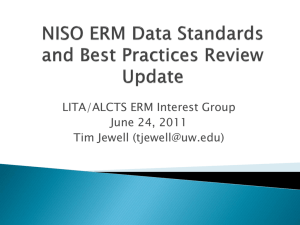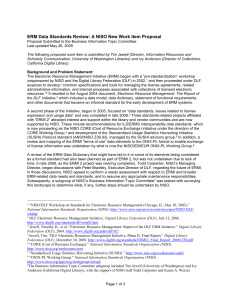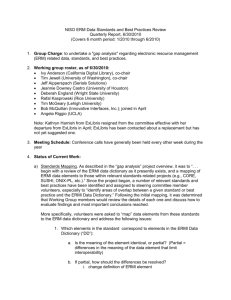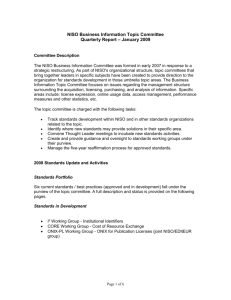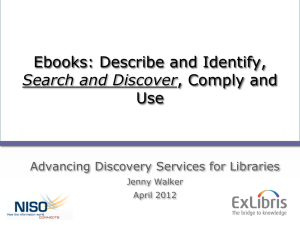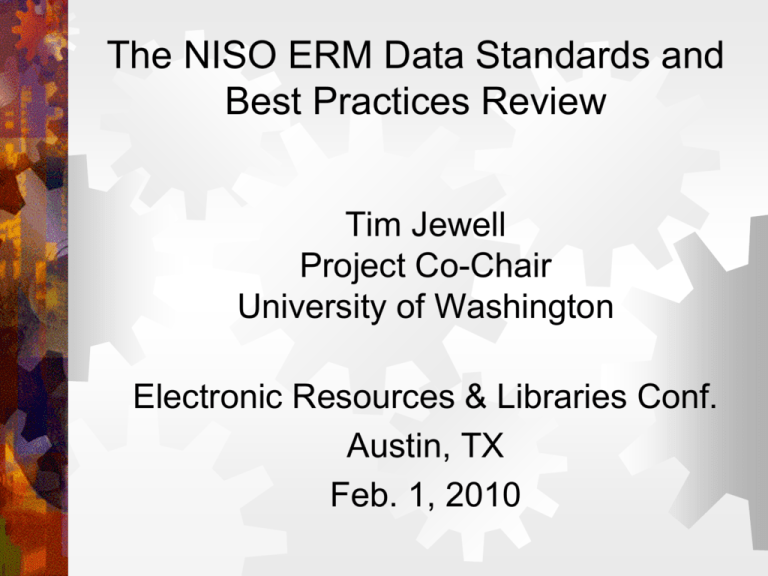
The NISO ERM Data Standards and
Best Practices Review
Tim Jewell
Project Co-Chair
University of Washington
Electronic Resources & Libraries Conf.
Austin, TX
Feb. 1, 2010
A Working Definition for ERMs
“Tools for managing the license agreements,
related administrative information, and internal
processes associated with collections of licensed
electronic resources.”
Ellen Duranceau, Against The Grain, June 2005
Part 1: ERMI
ERMI “Family History”
Chandler & Jewell Web Hub: 2001
Jewell DLF study (“Selection and Presentation of
Commercially Available Electronic Resources”): 2001
DLF/NISO Pre-standardization Workshop: 2002
DLF ERMI (Electronic Resource Management
Initiative): 2002-2004
ERMI 2 (Electronic Resource Management Initiative,
Phase II): 2006-2008
NISO ERM Data Standards and Best Practices
Review: 2009+
The DLF Electronic Resource
Management Initiative, Phase I
ERMI Goals
“Develop common specifications and tools for
managing the license agreements, related
administrative information, and internal processes
associated with collections of licensed electronic
resources”
Describe architectures needed for electronic resource
management
Foster systems development
Promote best practices and standards
http://www.diglib.org/standards/dlf-erm02.htm
Functional Requirements
Support
the ‘Life Cycle’ of electronic
resources:
Selection
and acquisition
Access provision
Resource administration
User support and troubleshooting (staff
and end-users)
Renewal and retention decisions
E-Resource Acquisitions Workflow
Propose
Evaluate
Content, Platform, Cost
OK
License
Technical Feasibility
OK
OK
Approve / Negotiate
Order / Register for Access
Implement
Proxy Server
Portal
Catalog
Link Resolver
Ongoing Management / Stewardship
License
terms
Price
Trial
Assess
need/budget
Order, Register
Evaluate
Catalog
User
feedback
Investigate
Digital Registry
Usage stats
Review
alternatives
Review
problems
Evaluate
Monitor
Provide Access
Track problems
Gateway
Contact info
Link Resolver
Provide Support
Inform users
Proxy server
Administer
Payment, manage
financials
Setup contacts
Troubleshoot
Manage changes
Provide Training
Customize interface
Holdings
management
Set up usage statistics
The DLF ERMI 2004 Report
Relationships (Data Model)
Information (Data Dictionary)
Packages and their constituent parts
Knowing which resources share the same interface,
license terms, business terms…
License permissions and constraints
User IDs, passwords, administrative info
Contacts for support and troubleshooting
Cancellation restrictions, price caps, etc.
Workflows (Functional Requirements)
Mounting Trials
Routing Licenses
Placing Orders
Implementing access
Notifying relevant staff
ERMI Report “by the numbers”:
1
Entity Relationship Diagram
4 ERM Workflow Flowcharts
8 Main Functional Requirements, 47
numbered subheads, +109 more
detailed specifications
27 Data Structure “entities”
~ 300 Data Elements in Dictionary
10
“Quick Fix” XML data elements
ERMI Successes
Articulated the relationships among licenses, resources,
packages, providers, and platforms
Fostered recognition that licenses and related metadata had
to be properly managed
Spawned the development of systems to manage e-resource
information
“If last year’s hot product was federated searching, then 2004
belongs to electronic resources management (ERM)” and of the
impact of the DLF ERMI documents: “in a nearly unprecedented
move, nearly every large automation vendor has used the
specifications created by librarians.”
Andrew Pace, American Libraries, 2004
But . . .
ERMI was not a Standard
AND . . .
All has not been well
in ERMI Land . . .
Abandoned
vendor development
projects
Slow, difficult, partial and/or failed
implementations
Deferred purchase decisions
Recent conference program themes:
ALA:
“Promise and Disappointment”
ICOLC: “What Went Wrong?”
“What is to be done?”
Part 2: the Emerging ERM
Standards Landscape
Why Standards?
Reduce re-keying
Reduce maintenance cost & disruption
Durability of data
Avoid supplier lock-in
Easier development path
Platform for collaboration
Whole system economies
Source: “The Business Case for Standards” (JISC)
Standards vs. Best Practices?
NISO
Standards
Balloted
Examples:
Formally
Designated Best Practices
Examples:
“Local”
MARC, ONIX-SOH, Z39.50
KBART, SERU
Best Practices
Current E-Resource Standards
Landscape
Standards & Best Practice
Groupings: 1
Link resolvers & knowledge bases
Open URL
KBART
Open URL Quality Metrics Project (new 2-year
NISO project)
Source: R. Kasprowski: “Best Practice & Standardization Initiatives
for Managing Electronic Resources,” ASIST Bull., Oct/Nov 2008
(v. 35 no. 1, pp. 13-19)
KBART
(Knowledge Bases and Related Tools)
Joint effort of NISO and the UK Serials Group
(launched January 2008)
Draft guidelines for best practice to effect smoother
interaction between members of the knowledge base
supply chain
Content standards for holdings data exchange
Centralized information portal
http://www.uksg.org/kbart/
Standards & Best Practice
Groupings: 2
The Work, manifestations & access points
MARC
DOIs and CrossRef
ONIX-SOH, ONIX-SPS, ONIX-SRN
Project Transfer
ISBN-13
ISSN-L
ISTC
Proposed NISO Work Item: Recommended
Practices for the Presentation and Identification of
E-Journals
Standards & Best Practice
Groupings: 3
Integration of usage & cost-related data
COUNTER
SUSHI
CORE
COUNTER: Counting Online Usage of
Networked Electronic Resources
Code
of Practice first released Jan 2003
Release 3 published Aug 2008
Code of Practice Addresses:
Content,
format, delivery mechanisms and
data processing rules for a set of core
usage reports
Terminology
Layout and format of reports
Processing of usage data
Delivery of reports
NISO Standardized Usage Statistics
Harvesting Initiative (SUSHI): Z39.93
A key project of the ERMI 2 initiative
Solves the problem of harvesting and managing
usage data from a growing number of providers
A web-services model for requesting data that
replaces the user’s need to download files from
vendor’s website
The SUSHI client runs on the library’s server, usually
associated with an ERM system.
The SUSHI server runs on the Content Provider’s server,
and has access to the usage data.
SUSHI is Now a Requirement of
the COUNTER 3 Code of Practice
Vendors must be SUSHIcompliant as of September 2009
Future of SUSHI:
Beyond COUNTER reports
SUSHI designed as a general protocol for
retrieving XML “reports”
Can be used for non-COUNTER usage reports
Can also be used to automate delivery of other
XML “messages”, such as:
Holdings data with ONIX-SOH
License terms with ONIX PL
Source: Oliver Pesch Presentation <http://www.niso.org/workrooms/sushi/info/OPESCH__SUSHI-Lille.ppt>
NISO Cost of Resource Exchange
(CORE): Z39.93-200x
DLF-ERMI White Paper on Interoperability between Acquisitions
Modules of Integrated Library Systems and Electronic Resource
Management Systems (January 2008)
Working Group Co-chairs
Ed Riding, SirsiDynix
Ted Koppel, Auto-Graphics
Facilitate transfer of acquisitions data between ILS and ERM
systems
provide a common method of requesting cost-related information from
an ILS for a specific electronic resource
Develop and refine the list of data elements to exchange
create a transport protocol useful in moving these data elements from one
system to another.
Write a small number of use cases
Draft Standard for Trial Use available through March 2010
http://www.niso.org/workrooms/core
Standards & Best Practice
Groupings: 4
Coding license terms & defining consensus
ONIX-PL
SERU
ERMI Terms of Use Elements
Fair Use Clause Indicator
Database Protection Override
Indicator
All Rights Reserved Indicator
Citation Requirement Details
Authorized User Definition
Local Authorized User
Definition Indicator
Other User Restriction Note
Other Use Restriction Note
Concurrent User
Digitally Copy*
Print Copy*
Scholarly Sharing*
Distance Education*
Interlibrary Loan Print or Fax*
Interlibrary Loan Secure
Electronic Transmission*
Interlibrary Loan Electronic*
Interlibrary Loan Record
Keeping Required Indicator
Course Reserve Print*
Course Reserve Electronic/
Cached Copy*
Electronic Link Permission*
Course Pack Print*
Course Pack Electronic*
Remote Access*
ERMI Permission Values
Permitted (explicit)
Permitted (interpreted)
Prohibited (explicit)
Prohibited (interpreted)
Silent (uninterpreted)
Not Applicable
EDItEUR review of ERMI
ERMI Phase 1 a basis for a license terms
expression standard; commissioned from
Rightscom
Valuable starting point, but further development
required
Terms dictionary would need a more rigorous
ontological structure
Proposed an <indecs>-based rights model:
licenses are about events (permitted,
prohibited, required, etc)
ONIX for Publications Licenses
(ONIX-PL)
Joint License Expression Working Group (LEWG)
sponsored by NISO, DLF, PLS and EDItEUR (2005)
now ONIX-PL Working Group (2008)
http://www.niso.org/workrooms/onixpl
A structured ontology and XML messaging protocol for
exchanging licensing information
ONIX-PL format specification v1.0 (2008)
Pilots underway by JISC and others
ONIX-ERMI mapping completed 2007
Enter SERU
Standards & Best Practice
Groupings: 5
Data
exchange using institutional
identifiers
(“licensing unit identifier”)
OCLC WorldCat Registry
Vcard
Shibboleth, Eduperson, NCIP?
I2
I2: Institutional Identifiers Working
Group
http://www.niso.org/workrooms/i2
Co-chairs
Grace Agnew, Rutgers University
Tina Feick, Harrassowitz
A globally unique, extensible identifier for
institutions for use in the information supply chain
E-Resources, Institutional Repositories, Library
Resource Management
Related work: OCLC Networking Names
http://oclcresearch.webjunction.org/networking_n
ames
Learning from ERMI, SUSHI,
CORE, etc.
Comprehensiveness
is difficult
To
describe
To build and implement
Example: e-metrics
Many useful sources, multiple views needed
E-resources
and markets change
quickly
Small-scale development works
Data sharing is necessary
Standards & Best Practice
Groupings: A Final Issue
“Relationships
A
among standards”
“NISO ERM Best Practices Framework?”
Part 3: The NISO ERM Data
Standards and Best Practices
Review
Timeline
Jan. 2009: Began exploratory focus group
discussions at ALA Midwinter
June 2009: NISO Business Information
Topics Committee approved project
Sep. 2009: Ivy Anderson presents at NISO
Library Resource Mgmt. Systems conference
Nov. 2009: Steering Committee finalized
Dec. 2009: Charge revised/finalized
April 2010: Report Deadline
ALA Midwinter 2009 NISO-led
Discussions: What We Heard
Discussed current ERM needs and future of ERMI with
over a dozen domain experts:
Librarians, system developers, standards representatives,
supply chain vendors
Libraries want:
Simplified license elements
Workflow tools and best practices
Authority control for products, vendors (including tracking
vendor name changes, acquisitions & mergers)
Management of data elements for future interoperability and
data transport
Holdings data for ebooks and journals – a huge pain point
for many customers – ““this resource from this publisher /
provider on this platform during this time period“
What We Heard: Flexibility
Need an ERMI lite for selected core elements
and lots of free form notes – for business
terms, resources in negotiation, etc.
Rapidly evolving business models – open
access, pay-per-view…
What We Heard: Conflicting Inputs
Focus on data elements, leave application to
system developers. User community should
shape application and use
Libraries need best practices guidance to
help them implement systems
What We Heard: ERMI Still Has
Many Champions
“ERMI has done a good job of identifying and
organizing the problem, not necessarily solving
it”
“One thing ERMI has done well is to define a
data dictionary that different systems can use to
move data around“
“ERMI should be the master custodian of data
elements”
We still need ERMI to create a context for how
all of the pieces need to work together”
Major Takeaways
About Standards
ERMI data model is still important for reference and context
Data dictionary is key to functionality and interoperability
License elements / values need simplification – ONIX-PL may
or may not serve library needs
Vendor and product identity management is an ongoing
problem
About Libraries
need to accurately represent vendor-resource-holdings
relationships
need to manage resources and holdings in a standardized and
shareable way
Libraries need help with workflows and best practices
About Systems
Existing systems are under-developed
Libraries need more specific functionality – ability to import /
export data, support everyday business activities / functions
Data exchange capability is critical
The NISO ERM Data Standards and
Best Practices Review: the “Plan”
Perform a ‘gap analysis’ regarding ERM-related data,
standards, and best practices
Begin with review of ERM data dictionary, mapping
elements to other relevant standards projects
Consult with vendors, libraries using ERM systems
and other stakeholders for additional feedback on data
requirements and ERM system implementation and
management issues.
More information at
http://www.niso.org/apps/group_public/workgroup.php?wg_abbrev=er
mreview
The NISO ERM Data Standards and
Best Practices Review: Deliverables
Recommend future of ERMI Data Dictionary
Describe typical challenges libraries face in
using currently available ERM systems and
services
Identify gaps in interoperability and best
practices
Gap Analysis Steering Group
Ivy Anderson (CDL, co-chair)
Tim Jewell (UW, co-chair)
Jeff Aipperspach (Serials Solutions)
Jeanne Downey (University of Houston)
Liam Earney (JISC)
Deberah England (Wright State)
Kathryn Harnish (Ex Libris)
Rafal Kasprowski (Rice)
Tim McGeary (Lehigh)
Angela Riggio (UCLA)
ERMI “Mapping” Strategy
Work from related standards and best
practices
Determine correspondence, overlap
Compare meanings, uses
Determine whether ERMI data dictionary
should address, or relevant standard
(w/revisions) sufficient to address ERM needs
Survey Work Plan
Assimilate recent ERM survey work
Identify major topics to focus on
Possibilities:
System implementation problems
Workflows, internal communication
Licensing
Consortial services
Cost per use/evaluation
Ebooks
Closing thoughts . . .
Budget
constraints are real, getting
tougher, and not going away
Libraries need to get more efficient
We need more:
Modularity,
specialized applications
Data sharing and transport
“Light weight” standards
Flexible, dynamic structures for “knitting”
pieces together where needed
To participate . . .
contact
the
NISO office at www.niso.org/contact
Tim at tjewell@uw.edu
Ivy at ivy.anderson@ucop.edu

